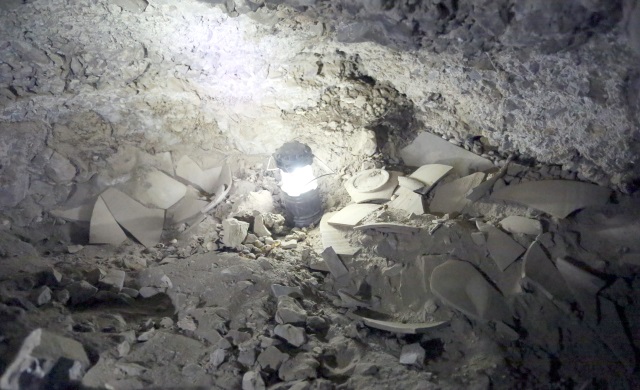The Land of Israel constantly reveals hidden treasures, testifying to its rich history and the Jews’ deep roots in the land. This time, archaeologists discovered more evidence surrounding the famous, ancient Dead Sea Scrolls.
In one of the most exciting archaeological discoveries in recent memory, and the most important in the last 60 years in the Dead Sea area, Israeli archaeologists have found more evidence surrounding the famous Dead Sea Scrolls.
Excavations in a cave on the cliffs west of Qumran, near the northwestern shore of the Dead Sea, found that Dead Sea scrolls from the Second Temple period were hidden in the cave, but were looted by Bedouins in the middle of the last century.
With the discovery of this cave, scholars now suggest that it should be numbered as the 12th cave found to be containing the rare and ancient scrolls.
The Dead Sea Scrolls are the world’s oldest biblical manuscripts, which were preserved for thousands of years in the desert’s arid climate and discovered in 1947. The collection is considered the crown jewel of Israeli antiquities.
The scrolls, mostly Hebrew writings from the Second Temple period, were discovered in the Qumran Caves. They are believed to have been written by members of a Jewish sect known as the Essenes.
The scrolls are currently hosted mainly at the Israel Museum in Jerusalem.
The surprising discovery, representing a milestone in Dead Sea Scroll research, was made by Dr. Oren Gutfeld and Ahiad Ovadia from the Hebrew University of Jerusalem’s Institute of Archaeology, with the help of Dr. Randall Price and students from Liberty University in Virginia.
The excavation is a part of the new “Operation Scroll” launched at the Israeli Antiquities Authority (IAA) to undertake systematic surveys and to excavate the caves in the Judean Desert.
Revelations About Recent and Ancient History
Excavation of the cave reveals that it had once contained some of the Dead Sea Scrolls. Numerous storage jars and lids from the Second Temple period were found hidden in niches along the walls of the cave and deep inside a long tunnel at its rear. The jars were all broken and their contents removed. The discovery of a pair of iron pickaxe heads from the 1950s, stored within the tunnel for later use, proves the cave was looted.
Until now, it was believed that only 11 caves had contained scrolls. With the finding of this last cave, scholars have now suggested that it would be numbered as Cave 12.
Like Cave 8, in which scroll jars but no scrolls were found, this cave will receive the designation Q12. The Q, for Qumran, stands in front of the number to indicate that no scrolls were found at the location.
“This exciting excavation is the closest we’ve come to discovering new Dead Sea scrolls in 60 years. Until now, it was accepted that Dead Sea scrolls were found only in 11 caves at Qumran, but now there is no doubt that this is the 12th cave,” said Gutfeld. “Although at the end of the day no scroll was found, and instead we ‘only’ found a piece of parchment rolled up in a jug that was being processed for writing, the findings indicate beyond any doubt that the cave contained scrolls that were stolen. The findings include the jars in which the scrolls and their covering were hidden, a leather strap for binding the scroll, a cloth that wrapped the scrolls, tendons and pieces of skin connecting fragments, and more.”
The items taken from the excavation site include not only the storage jars, which held the scrolls, but also fragments of scroll wrappings, a string that tied the scrolls, and a piece of processed leather that was a part of a scroll.
The discovery of pottery and numerous flint blades, arrowheads and a decorated stamp seal made of carnelian, a semi-precious stone, also indicate that this cave was used in the Chalcolithic and the Neolithic period.
Seeking a Deeper Understanding
The material, when published, will provide important new evidence for scholars on the archaeology of Qumran and the Dead Sea caves.
“The important discovery of another scroll cave attests to the fact that a lot of work remains to be done in the Judean Desert and finds of huge importance are still waiting to be discovered,” said Israel Hasson, director-general of the IAA. “We are in a race against time as antiquities thieves steal heritage assets worldwide for financial gain. The State of Israel needs to mobilize and allocate the necessary resources in order to launch a historic operation, together with the public, to carry out a systematic excavation of all the caves of the Judean Desert.”
By: Max Gelber, United with Israel
